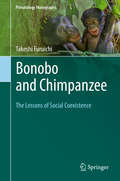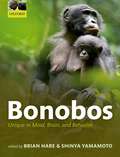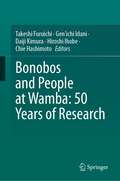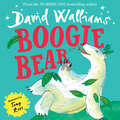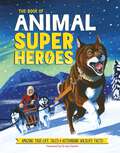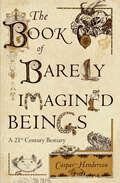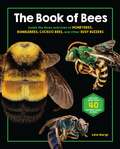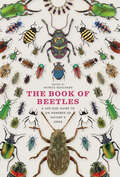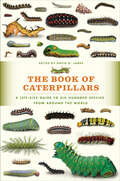- Table View
- List View
Bonobo and Chimpanzee: The Lessons of Social Coexistence (Primatology Monographs)
by Takeshi FuruichiThis book describes the similarities and differences between two species, bonobos and chimpanzees, based on the three decades the author has spent studying them in the wild, and shows how the contrasting nature of these two species is also reflected in human nature. The most important differences between bonobos and chimpanzees, our closest relatives, are the social mechanisms of coexistence in group life. Chimpanzees are known as a fairly despotic species in which the males exclusively dominate over the females, and maintain a rigid hierarchy. Chimpanzees have developed social intelligence to survive severe competition among males: by upholding the hierarchy of dominance, they can usually preserve peaceful relations among group members. In contrast, female bonobos have the same or even a higher social status than males. By evolving pseudo-estrus during their non-reproductive period, females have succeeded in moderating inter-male sexual competition, and in initiating mate selection. Although they are non-related in male-philopatric society, they usually aggregate in a group, enjoy priority access to food, determine which male is the alpha male, and generally maintain much more peaceful social relations compared to chimpanzees. Lastly, by identifying key mechanisms of social coexistence in these two species, the author also seeks to find solutions or “hope” for the peaceful coexistence of human beings."Takeshi Furuichi is one of very few scientists in the world familiar with both chimpanzees and bonobos. In lively prose, reflecting personal experience with apes in the rain forest, he compares our two closest relatives and explains the striking differences between the male- dominated and territorial chimpanzees and the female-centered gentle bonobos."Frans de Waal, author of Mama’s Last Hug - Animal Emotions and What They Tell Us about Ourselves (Norton, 2019)
The Bonobos: Behavior, Ecology, and Conservation (Developments in Primatology: Progress and Prospects)
by Takeshi Furuichi Jo ThompsonOnce one of the least studied of the great apes, this new text covers the latest research into these fascinating creatures. Split into two parts, it covers scientific research, which has attempted to answer why bonobos have some unique characteristics such as high social status of females and flexible social relationships. Then, it moves on to conservation. Both the local and global aspects of the factors threatening the wild bonobo population are reviewed.
Bonobos: Unique in Mind, Brain, and Behavior
The bonobo, along with the chimpanzee, is one of our two closest living relatives. Their relatively narrow geographic range (south of the Congo River in the Democratic Republic of Congo) combined with the history of political instability in the region, has made their scientific study extremely difficult. In contrast, there are dozens of wild and captive sites where research has been conducted for decades with chimpanzees. Because data sets on bonobos have been so hard to obtain and so few large-scale studies have been published, the majority of researchers have treated chimpanzee data as being representative of both species. However, this misconception is now rapidly changing. With relative stability in the DRC for over a decade and a growing community of bonobos living in zoos and sanctuaries internationally, there has been an explosion of scientific interest in the bonobo with dozens of high impact publications focusing on this fascinating species. This research has revealed exactly how unique bonobos are in their brains and behavior, and reminds us why it is so important that we redouble our efforts to protect the few remaining wild populations of this iconic and highly endangered great ape species.
Bonobos and People at Wamba: 50 Years of Research
by Takeshi Furuichi Gen'Ichi Idani Daiji Kimura Hiroshi Ihobe Chie HashimotoThis book reviews all the findings about bonobos and the local people of Wamba village in the Luo Scientific Reserve in the Democratic Republic of the Congo over the last 50 years. In 1973, Takayoshi Kano, a Japanese primatologist, traveled across a vast area of the Congo Basin with a bicycle and found Wamba village to be a promising site to start his first studies on wild bonobos. Since then, many researchers from Japan and all over the world have been working at Wamba, now the longest standing study site, to uncover various aspects of the ecology and behavior of this most recently identified great ape species. The researchers study bonobo behaviors and carry out various activities for the conservation of bonobos. They also conduct anthropological studies of local people who live with bonobos and believe them to be distant relatives from the same family, living in the forest. This book is published in commemoration of 2023 marking the 50th year of study. The main chapters are contributed by active researchers studying bonobos and the local people at Wamba. The book also includes contributions from various eminent researchers who have carried out short-term research or have supported research at Wamba, which helps place these studies of bonobos in a broader primatological or anthropological perspective. This book will be a useful resource for professional researchers in primatology and anthropology, as well as graduate or undergraduate students interested in these research fields.
Bonzo's War: Animals Under Fire 1939 -1945
by Clare CampbellWhat was it like to be a dog or cat when the world was at war? When food was rationed and cities were bombed? Pets (on the whole) do not write memoirs, so to find the answer to that question, Clare Campbell went in search of voices of those people whose lives were entwined with animals.She found stories - inspiring and harrowing - of animals under fire, of evacuated and homeless pets, of brave animals who provided comfort to humans while the bombs fell. Of pets unwittingly entangled in war, like the Dunkirk pets and the camp followers who switched sides to stay alive; and the 6,000 dogs recruited by the British Army - loaned for duty by their families - many never to return. Meanwhile with food in short supply, government officials launched a ruthless campaigns against pets... Thoroughly researched and deeply moving, Bonzo's War gives a fascinating account of, and platform for, the forgotten stories as yet unheard, of the creatures big and small caught up in a human conflict far beyond understanding.
Boogie Bear
by David WalliamsFrom Number One bestselling author David Walliams comes a hilarious and heartwarming picture book, brilliantly illustrated by the artistic genius, Tony Ross.
Boojer
by Alison PrinceBoojer is sick of being stuck in a hutch with no company and an owner who hardly ever remembers to feed him. Encouraged by some cheerful mice, he manages to escape. Boojer is only in search of juicy carrots and a friend, but he gets far more than he bargained for...
The Book Cat (Marshmallow Pie The Cat Superstar Ser. #Book 1)
by Polly FaberThis is a classic wartime tale of a (real!) cat who made his home at the Faber offices and decided he'd never leave.'This time we need to get you - get all of the kittens, safe out of London,' said Morgan decisively . . . 'To have a chance for a better life, well, let's just say, I've got an idea.'Morgan is a young orphan who lives off scavenging - until he finds a cosy home at a famous London publishing house. Over time he learns a trade - and soon becomes the very best book cat in the business. And then the Blitz begins. Morgan finds himself training up twenty odd kittens to be book cats, and then there is the small matter of secretly evacuating them out of London. Happily, Morgan has a plan.Set in war-torn London, charmingly illustrated, and full of heart and verve.
The Book of Animal Superheroes: Amazing True-Life Tales; Astounding Wildlife Facts
by David Dean Camilla de BedoyereDiscover real-life stories of animals who have achieved the most heroic or astounding feats, and tons of fascinating animal facts - from dogs, cats and rabbits to birds, whales and insects.A fascinating combination of true-life tales of heroic animals and information on incredible topics such as animal senses, intelligence, communication and the importance of animal conservation.Included are the heart-warming stories of Mari the Japanese Shiba Inu who saved her puppies and human owner from the destruction of an earthquake, Digit the gorilla whose brave actions highlighted the importance of gorilla conversation worldwide, Lin Wang the war elephant who became a national hero and so many more.A real highlight of this gorgeous book is the stunning artwork of David Dean, whose paintings bring drama and atmosphere to every scene, and a foreword by television presenter and veterinarian Jess French.
Book of Animals (Here We Are)
by Oliver JeffersA spectacular concept book from world-renowned artist Oliver Jeffers, based on his million-copy selling, global phenomenon Here We Are!
The Book of Barely Imagined Beings: A 21st Century Bestiary
by Caspar HendersonFrom medieval bestiaries to Borges’s Book of Imaginary Beings, we’ve long been enchanted by extraordinary animals, be they terrifying three-headed dogs or asps impervious to a snake charmer’s song. But bestiaries are more than just zany zoology—they are artful attempts to convey broader beliefs about human beings and the natural order. Today, we no longer fear sea monsters or banshees. But from the infamous honey badger to the giant squid, animals continue to captivate us with the things they can do and the things they cannot, what we know about them and what we don’t. With The Book of Barely Imagined Beings, Caspar Henderson offers readers a fascinating, beautifully produced modern-day menagerie. But whereas medieval bestiaries were often based on folklore and myth, the creatures that abound in Henderson’s book—from the axolotl to the zebrafish—are, with one exception, very much with us, albeit sometimes in depleted numbers. The Book of Barely Imagined Beings transports readers to a world of real creatures that seem as if they should be made up—that are somehow more astonishing than anything we might have imagined. The yeti crab, for example, uses its furry claws to farm the bacteria on which it feeds. The waterbear, meanwhile, is among nature’s “extreme survivors,” able to withstand a week unprotected in outer space. These and other strange and surprising species invite readers to reflect on what we value—or fail to value—and what we might change. A powerful combination of wit, cutting-edge natural history, and philosophical meditation, The Book of Barely Imagined Beings is an infectious and inspiring celebration of the sheer ingenuity and variety of life in a time of crisis and change.
The Book of Barely Imagined Beings: A 21st Century Bestiary
by Caspar HendersonFrom medieval bestiaries to Borges’s Book of Imaginary Beings, we’ve long been enchanted by extraordinary animals, be they terrifying three-headed dogs or asps impervious to a snake charmer’s song. But bestiaries are more than just zany zoology—they are artful attempts to convey broader beliefs about human beings and the natural order. Today, we no longer fear sea monsters or banshees. But from the infamous honey badger to the giant squid, animals continue to captivate us with the things they can do and the things they cannot, what we know about them and what we don’t. With The Book of Barely Imagined Beings, Caspar Henderson offers readers a fascinating, beautifully produced modern-day menagerie. But whereas medieval bestiaries were often based on folklore and myth, the creatures that abound in Henderson’s book—from the axolotl to the zebrafish—are, with one exception, very much with us, albeit sometimes in depleted numbers. The Book of Barely Imagined Beings transports readers to a world of real creatures that seem as if they should be made up—that are somehow more astonishing than anything we might have imagined. The yeti crab, for example, uses its furry claws to farm the bacteria on which it feeds. The waterbear, meanwhile, is among nature’s “extreme survivors,” able to withstand a week unprotected in outer space. These and other strange and surprising species invite readers to reflect on what we value—or fail to value—and what we might change. A powerful combination of wit, cutting-edge natural history, and philosophical meditation, The Book of Barely Imagined Beings is an infectious and inspiring celebration of the sheer ingenuity and variety of life in a time of crisis and change.
The Book of Barely Imagined Beings: A 21st Century Bestiary
by Caspar HendersonFrom medieval bestiaries to Borges’s Book of Imaginary Beings, we’ve long been enchanted by extraordinary animals, be they terrifying three-headed dogs or asps impervious to a snake charmer’s song. But bestiaries are more than just zany zoology—they are artful attempts to convey broader beliefs about human beings and the natural order. Today, we no longer fear sea monsters or banshees. But from the infamous honey badger to the giant squid, animals continue to captivate us with the things they can do and the things they cannot, what we know about them and what we don’t. With The Book of Barely Imagined Beings, Caspar Henderson offers readers a fascinating, beautifully produced modern-day menagerie. But whereas medieval bestiaries were often based on folklore and myth, the creatures that abound in Henderson’s book—from the axolotl to the zebrafish—are, with one exception, very much with us, albeit sometimes in depleted numbers. The Book of Barely Imagined Beings transports readers to a world of real creatures that seem as if they should be made up—that are somehow more astonishing than anything we might have imagined. The yeti crab, for example, uses its furry claws to farm the bacteria on which it feeds. The waterbear, meanwhile, is among nature’s “extreme survivors,” able to withstand a week unprotected in outer space. These and other strange and surprising species invite readers to reflect on what we value—or fail to value—and what we might change. A powerful combination of wit, cutting-edge natural history, and philosophical meditation, The Book of Barely Imagined Beings is an infectious and inspiring celebration of the sheer ingenuity and variety of life in a time of crisis and change.
The Book of Barely Imagined Beings: A 21st Century Bestiary
by Caspar HendersonFrom medieval bestiaries to Borges’s Book of Imaginary Beings, we’ve long been enchanted by extraordinary animals, be they terrifying three-headed dogs or asps impervious to a snake charmer’s song. But bestiaries are more than just zany zoology—they are artful attempts to convey broader beliefs about human beings and the natural order. Today, we no longer fear sea monsters or banshees. But from the infamous honey badger to the giant squid, animals continue to captivate us with the things they can do and the things they cannot, what we know about them and what we don’t. With The Book of Barely Imagined Beings, Caspar Henderson offers readers a fascinating, beautifully produced modern-day menagerie. But whereas medieval bestiaries were often based on folklore and myth, the creatures that abound in Henderson’s book—from the axolotl to the zebrafish—are, with one exception, very much with us, albeit sometimes in depleted numbers. The Book of Barely Imagined Beings transports readers to a world of real creatures that seem as if they should be made up—that are somehow more astonishing than anything we might have imagined. The yeti crab, for example, uses its furry claws to farm the bacteria on which it feeds. The waterbear, meanwhile, is among nature’s “extreme survivors,” able to withstand a week unprotected in outer space. These and other strange and surprising species invite readers to reflect on what we value—or fail to value—and what we might change. A powerful combination of wit, cutting-edge natural history, and philosophical meditation, The Book of Barely Imagined Beings is an infectious and inspiring celebration of the sheer ingenuity and variety of life in a time of crisis and change.
The Book of Barely Imagined Beings: A 21st Century Bestiary
by Caspar HendersonFrom medieval bestiaries to Borges’s Book of Imaginary Beings, we’ve long been enchanted by extraordinary animals, be they terrifying three-headed dogs or asps impervious to a snake charmer’s song. But bestiaries are more than just zany zoology—they are artful attempts to convey broader beliefs about human beings and the natural order. Today, we no longer fear sea monsters or banshees. But from the infamous honey badger to the giant squid, animals continue to captivate us with the things they can do and the things they cannot, what we know about them and what we don’t. With The Book of Barely Imagined Beings, Caspar Henderson offers readers a fascinating, beautifully produced modern-day menagerie. But whereas medieval bestiaries were often based on folklore and myth, the creatures that abound in Henderson’s book—from the axolotl to the zebrafish—are, with one exception, very much with us, albeit sometimes in depleted numbers. The Book of Barely Imagined Beings transports readers to a world of real creatures that seem as if they should be made up—that are somehow more astonishing than anything we might have imagined. The yeti crab, for example, uses its furry claws to farm the bacteria on which it feeds. The waterbear, meanwhile, is among nature’s “extreme survivors,” able to withstand a week unprotected in outer space. These and other strange and surprising species invite readers to reflect on what we value—or fail to value—and what we might change. A powerful combination of wit, cutting-edge natural history, and philosophical meditation, The Book of Barely Imagined Beings is an infectious and inspiring celebration of the sheer ingenuity and variety of life in a time of crisis and change.
The Book of Barely Imagined Beings: A 21st Century Bestiary
by Caspar HendersonFrom medieval bestiaries to Borges’s Book of Imaginary Beings, we’ve long been enchanted by extraordinary animals, be they terrifying three-headed dogs or asps impervious to a snake charmer’s song. But bestiaries are more than just zany zoology—they are artful attempts to convey broader beliefs about human beings and the natural order. Today, we no longer fear sea monsters or banshees. But from the infamous honey badger to the giant squid, animals continue to captivate us with the things they can do and the things they cannot, what we know about them and what we don’t. With The Book of Barely Imagined Beings, Caspar Henderson offers readers a fascinating, beautifully produced modern-day menagerie. But whereas medieval bestiaries were often based on folklore and myth, the creatures that abound in Henderson’s book—from the axolotl to the zebrafish—are, with one exception, very much with us, albeit sometimes in depleted numbers. The Book of Barely Imagined Beings transports readers to a world of real creatures that seem as if they should be made up—that are somehow more astonishing than anything we might have imagined. The yeti crab, for example, uses its furry claws to farm the bacteria on which it feeds. The waterbear, meanwhile, is among nature’s “extreme survivors,” able to withstand a week unprotected in outer space. These and other strange and surprising species invite readers to reflect on what we value—or fail to value—and what we might change. A powerful combination of wit, cutting-edge natural history, and philosophical meditation, The Book of Barely Imagined Beings is an infectious and inspiring celebration of the sheer ingenuity and variety of life in a time of crisis and change.
The Book of Bees: Inside the Hives and Lives of Honeybees, Bumblebees, Cuckoo Bees, and Other Busy Buzzers
by Lela NargiFilled with more than 150 beautiful, crystal-clear photos and bee fun facts, The Book of Bees is the ultimate guide for kids to explore the lives of these stunning insects and learn about their critical role in fostering a sustainable, healthy Earth.Did you know there are blue bees and green bees? Or that one species of bee nests in snail shells? Or that many bees don&’t live in hives? With more than 20,000 species of bees worldwide, there&’s more to bees than just honey! The Book of Bees gives curious kids a close-up view of busy buzzers from around the world. From the familiar Western honeybee to the extra-large Himalayan giant honeybee and Australia&’s vibrant neon cuckoo bee, these pages are packed with detailed photos and fascinating facts on more than 50 species of bees. In-depth species profiles help you identify bees, learn about bee-havior, and find your favorites! And special features examine topics like hive life, nest cells, and other pollinators. The world of bees is exciting and surprising—and The Book of Bees will leave you buzzing!
The Book of Beetles: A Life-Size Guide to Six Hundred of Nature's Gems
by Patrice BouchardWhen renowned British geneticist J. B. S. Haldane was asked what could be inferred about God from a study of his works, Haldane replied, “An inordinate fondness for beetles.” With 350,000 known species, and scientific estimates that millions more have yet to be identified, their abundance is indisputable as is their variety. They range from the delightful summer firefly to the one-hundred-gram Goliath beetle. Beetles offer a dazzling array of shapes, sizes, and colors that entice scientists and collectors across the globe. The Book of Beetles celebrates the beauty and diversity of this marvelous insect. Six hundred significant beetle species are covered, with each entry featuring a distribution map, basic biology, conservation status, and information on cultural and economic significance. Full-color photos show the beetles both at their actual size and enlarged to show details, such as the sextet of spots that distinguish the six-spotted tiger beetle or the jagged ridges of the giant-jawed sawyer beetle. Based in the most up-to-date science and accessibly written, the descriptive text will appeal to researchers and armchair coleopterists alike. The humble beetle continues to grow in popularity, taking center stage in biodiversity studies, sustainable agriculture programs, and even the dining rooms of adventurous and eco-conscious chefs. The Book of Beetles is certain to become the authoritative reference on these remarkably adaptable and beautiful creatures.
The Book of Beetles: A Life-Size Guide to Six Hundred of Nature's Gems
by Patrice BouchardWhen renowned British geneticist J. B. S. Haldane was asked what could be inferred about God from a study of his works, Haldane replied, “An inordinate fondness for beetles.” With 350,000 known species, and scientific estimates that millions more have yet to be identified, their abundance is indisputable as is their variety. They range from the delightful summer firefly to the one-hundred-gram Goliath beetle. Beetles offer a dazzling array of shapes, sizes, and colors that entice scientists and collectors across the globe. The Book of Beetles celebrates the beauty and diversity of this marvelous insect. Six hundred significant beetle species are covered, with each entry featuring a distribution map, basic biology, conservation status, and information on cultural and economic significance. Full-color photos show the beetles both at their actual size and enlarged to show details, such as the sextet of spots that distinguish the six-spotted tiger beetle or the jagged ridges of the giant-jawed sawyer beetle. Based in the most up-to-date science and accessibly written, the descriptive text will appeal to researchers and armchair coleopterists alike. The humble beetle continues to grow in popularity, taking center stage in biodiversity studies, sustainable agriculture programs, and even the dining rooms of adventurous and eco-conscious chefs. The Book of Beetles is certain to become the authoritative reference on these remarkably adaptable and beautiful creatures.
The Book of Beetles: A Life-Size Guide to Six Hundred of Nature's Gems
by Patrice BouchardWhen renowned British geneticist J. B. S. Haldane was asked what could be inferred about God from a study of his works, Haldane replied, “An inordinate fondness for beetles.” With 350,000 known species, and scientific estimates that millions more have yet to be identified, their abundance is indisputable as is their variety. They range from the delightful summer firefly to the one-hundred-gram Goliath beetle. Beetles offer a dazzling array of shapes, sizes, and colors that entice scientists and collectors across the globe. The Book of Beetles celebrates the beauty and diversity of this marvelous insect. Six hundred significant beetle species are covered, with each entry featuring a distribution map, basic biology, conservation status, and information on cultural and economic significance. Full-color photos show the beetles both at their actual size and enlarged to show details, such as the sextet of spots that distinguish the six-spotted tiger beetle or the jagged ridges of the giant-jawed sawyer beetle. Based in the most up-to-date science and accessibly written, the descriptive text will appeal to researchers and armchair coleopterists alike. The humble beetle continues to grow in popularity, taking center stage in biodiversity studies, sustainable agriculture programs, and even the dining rooms of adventurous and eco-conscious chefs. The Book of Beetles is certain to become the authoritative reference on these remarkably adaptable and beautiful creatures.
The Book of Beetles: A Life-Size Guide to Six Hundred of Nature's Gems
by Patrice BouchardWhen renowned British geneticist J. B. S. Haldane was asked what could be inferred about God from a study of his works, Haldane replied, “An inordinate fondness for beetles.” With 350,000 known species, and scientific estimates that millions more have yet to be identified, their abundance is indisputable as is their variety. They range from the delightful summer firefly to the one-hundred-gram Goliath beetle. Beetles offer a dazzling array of shapes, sizes, and colors that entice scientists and collectors across the globe. The Book of Beetles celebrates the beauty and diversity of this marvelous insect. Six hundred significant beetle species are covered, with each entry featuring a distribution map, basic biology, conservation status, and information on cultural and economic significance. Full-color photos show the beetles both at their actual size and enlarged to show details, such as the sextet of spots that distinguish the six-spotted tiger beetle or the jagged ridges of the giant-jawed sawyer beetle. Based in the most up-to-date science and accessibly written, the descriptive text will appeal to researchers and armchair coleopterists alike. The humble beetle continues to grow in popularity, taking center stage in biodiversity studies, sustainable agriculture programs, and even the dining rooms of adventurous and eco-conscious chefs. The Book of Beetles is certain to become the authoritative reference on these remarkably adaptable and beautiful creatures.
The Book of Caterpillars: A Life-Size Guide to Six Hundred Species from around the World
by David G. JamesThe weird and wonderful world of insects boasts some of the strangest creatures found in nature, and caterpillars are perhaps the most bizarre of all. While most of us picture caterpillars as cute fuzzballs munching on leaves, there is much more to them than we imagine. A caterpillar’s survival hinges on finding enough food and defending itself from the array of natural enemies lined up to pounce and consume. And the astounding adaptations and strategies they have developed to maximize their chances of becoming a butterfly or moth are only just beginning to be understood, from the Spicebush Swallowtail caterpillar that resembles a small snake to the Eastern Carpenter Bee Hawkmoth caterpillar that attempts to dissuade potential predators by looking like a diseased leaf. The Book of Caterpillars unveils the mysteries of six hundred species from around the world, introducing readers to the complexity and beauty of these underappreciated insects. With the advent of high-quality digital macrophotography, the world of caterpillars is finally opening up. The book presents a wealth of stunning imagery that showcases the astonishing diversity of caterpillar design, structure, coloration, and patterning. Each entry also features a two-tone engraving of the adult specimen, emphasizing the wing patterns and shades, as well as a population distribution map and table of essential information that includes their habitat, typical host plants, and conservation status. Throughout the book are fascinating facts that will enthrall expert entomologists and curious collectors alike. A visually rich and scientifically accurate guide to six hundred of the world’s most peculiar caterpillars, this volume presents readers with a rare, detailed look at these intriguing forms of insect life.
The Book of Caterpillars: A Life-Size Guide to Six Hundred Species from around the World
by David G. JamesThe weird and wonderful world of insects boasts some of the strangest creatures found in nature, and caterpillars are perhaps the most bizarre of all. While most of us picture caterpillars as cute fuzzballs munching on leaves, there is much more to them than we imagine. A caterpillar’s survival hinges on finding enough food and defending itself from the array of natural enemies lined up to pounce and consume. And the astounding adaptations and strategies they have developed to maximize their chances of becoming a butterfly or moth are only just beginning to be understood, from the Spicebush Swallowtail caterpillar that resembles a small snake to the Eastern Carpenter Bee Hawkmoth caterpillar that attempts to dissuade potential predators by looking like a diseased leaf. The Book of Caterpillars unveils the mysteries of six hundred species from around the world, introducing readers to the complexity and beauty of these underappreciated insects. With the advent of high-quality digital macrophotography, the world of caterpillars is finally opening up. The book presents a wealth of stunning imagery that showcases the astonishing diversity of caterpillar design, structure, coloration, and patterning. Each entry also features a two-tone engraving of the adult specimen, emphasizing the wing patterns and shades, as well as a population distribution map and table of essential information that includes their habitat, typical host plants, and conservation status. Throughout the book are fascinating facts that will enthrall expert entomologists and curious collectors alike. A visually rich and scientifically accurate guide to six hundred of the world’s most peculiar caterpillars, this volume presents readers with a rare, detailed look at these intriguing forms of insect life.
The Book of Caterpillars: A Life-Size Guide to Six Hundred Species from around the World
by David G. James Sally Morgan Andrei SourakovThe weird and wonderful world of insects boasts some of the strangest creatures found in nature, and caterpillars are perhaps the most bizarre of all. While most of us picture caterpillars as cute fuzzballs munching on leaves, there is much more to them than we imagine. A caterpillar’s survival hinges on finding enough food and defending itself from the array of natural enemies lined up to pounce and consume. And the astounding adaptations and strategies they have developed to maximize their chances of becoming a butterfly or moth are only just beginning to be understood, from the Spicebush Swallowtail caterpillar that resembles a small snake to the Eastern Carpenter Bee Hawkmoth caterpillar that attempts to dissuade potential predators by looking like a diseased leaf. The Book of Caterpillars unveils the mysteries of six hundred species from around the world, introducing readers to the complexity and beauty of these underappreciated insects. With the advent of high-quality digital macrophotography, the world of caterpillars is finally opening up. The book presents a wealth of stunning imagery that showcases the astonishing diversity of caterpillar design, structure, coloration, and patterning. Each entry also features a two-tone engraving of the adult specimen, emphasizing the wing patterns and shades, as well as a population distribution map and table of essential information that includes their habitat, typical host plants, and conservation status. Throughout the book are fascinating facts that will enthrall expert entomologists and curious collectors alike. A visually rich and scientifically accurate guide to six hundred of the world’s most peculiar caterpillars, this volume presents readers with a rare, detailed look at these intriguing forms of insect life.
The Book of Caterpillars: A Life-Size Guide to Six Hundred Species from around the World
The weird and wonderful world of insects boasts some of the strangest creatures found in nature, and caterpillars are perhaps the most bizarre of all. While most of us picture caterpillars as cute fuzzballs munching on leaves, there is much more to them than we imagine. A caterpillar’s survival hinges on finding enough food and defending itself from the array of natural enemies lined up to pounce and consume. And the astounding adaptations and strategies they have developed to maximize their chances of becoming a butterfly or moth are only just beginning to be understood, from the Spicebush Swallowtail caterpillar that resembles a small snake to the Eastern Carpenter Bee Hawkmoth caterpillar that attempts to dissuade potential predators by looking like a diseased leaf. The Book of Caterpillars unveils the mysteries of six hundred species from around the world, introducing readers to the complexity and beauty of these underappreciated insects. With the advent of high-quality digital macrophotography, the world of caterpillars is finally opening up. The book presents a wealth of stunning imagery that showcases the astonishing diversity of caterpillar design, structure, coloration, and patterning. Each entry also features a two-tone engraving of the adult specimen, emphasizing the wing patterns and shades, as well as a population distribution map and table of essential information that includes their habitat, typical host plants, and conservation status. Throughout the book are fascinating facts that will enthrall expert entomologists and curious collectors alike. A visually rich and scientifically accurate guide to six hundred of the world’s most peculiar caterpillars, this volume presents readers with a rare, detailed look at these intriguing forms of insect life.
